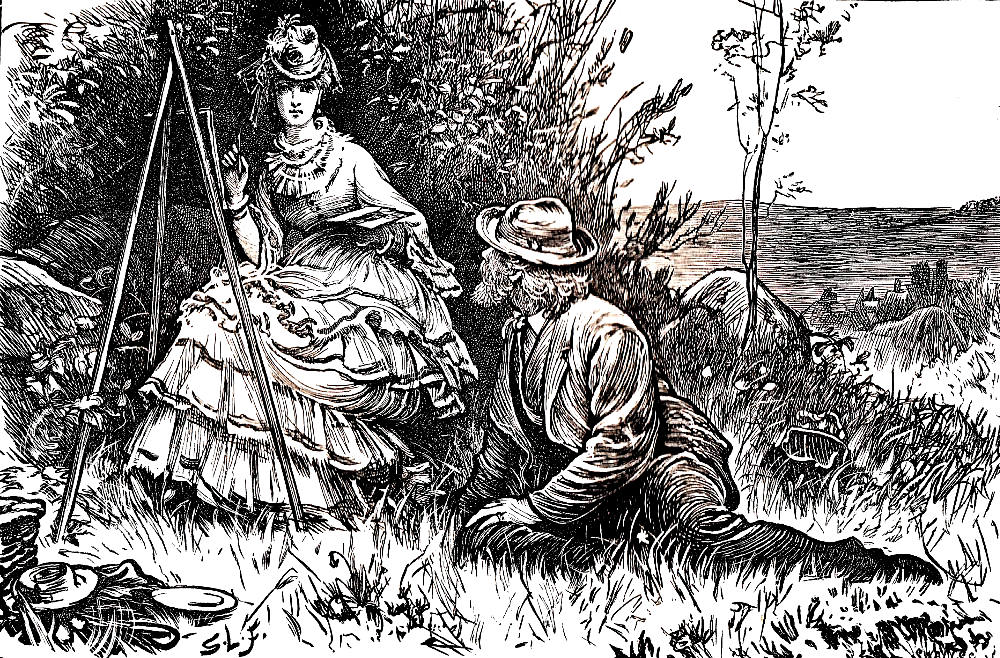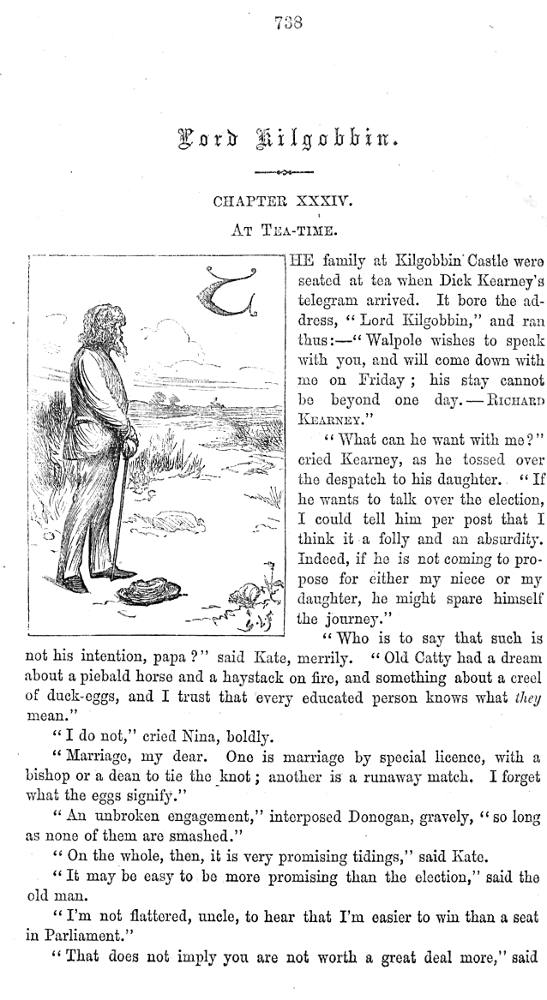
"True, there is no tender light there," muttered he, gazing at her eyes by Sir Luke Fildes; engraver, Swain. Tenth illustration for Charles Lever's Lord Kilgobbin, 10.5 cm high by 15.8 cm wide (4 by 6 ¼ inches), framed, full-page illustration for Chapter XXXVI, "The Excursion," facing p. 211. Reprinted from the Cornhill Magazine, Part 9 (June 1871), facing p. 738. [Click on the illustration to enlarge it.]
Passage Illustrated: A Pastoral Idyll

Right: The initial page for the ninth instalment in Volume XXIII of the Cornhill Magazine (May, 1871), 738.
"Shall I do what will best please myself? If so, it will be to lie here and look at you."
"Be it so," said she, with a sigh. "I have always thought, in looking at them, how saints are bored by being worshipped — it adds fearfully to martyrdom, but happily I am used to it. “Oh, the vanity of that girl!” Yes, sir, say it out: tell her frankly that if she has no friend to caution her against this besetting wile, that you will be that friend. Tell her that whatever she has of attraction is spoiled and marred by this self-consciousness, and that just as you are a rebel without knowing it, so should she be charming and never suspect it. Is not that coming nicely,’ said she, pointing to the drawing; ‘see how that tender light is carried down from those grey walls to the banks beneath, and dies away in that little pool, where the faintest breath of air is rustling. Don’t look at me, sir, look at my drawing."
"True, there is no tender light there," muttered he, gazing at her eyes, where the enormous size of the pupils had given a character of steadfast brilliancy, quite independent of shape, or size, or colour.
"You know very little about it," said she saucily; then, bending over the drawing, she said, "That middle distance wants a bit of colour: you shall aid me here."
"How am I to aid you?" asked he, in sheer simplicity.
"I mean that you should be that bit of colour. There, take my scarlet cloak, and perch yourself yonder on that low rock. A few minutes will do. Was there ever immortality so cheaply purchased! Your biographer shall tell that you were the figure in that famous sketch — what will be called in the cant of art, one of Nina Kostalergi’s earliest and happiest efforts. There, now, dear Mr. Donogan, do as you are bid."
"Do you know the Greek ballad, where a youth remembers that the word 'dear' has been coupled with his name — a passing courtesy, if even so much, but enough to light up a whole chamber in his heart?"
"I know nothing of Greek ballads. How does it go?"
"It is a simple melody, in a low key." And he sang, in a deep but tremulous voice, to a very plaintive air — [Chapter XXXVI, "The Excursion," 211]
Commentary: Introducing the Fenian rebel in the ninth serial number
Picking up the thread of the abortive Fenian raid on Kilgobbin Castle in Chapter X, "The Search for Arms," Lever now introduces a new and controversial character, Daniel Donogan, the Fenian rebel. He has just been released from Darmouth Gaol, according to a letter which Dick Kearney finds in his pocket-book, and makes his entrance asleep in Kearney's own bed in the Trinity College rooms that Kearney shares with Atlee. Undoubtedly, reasons Dick, Donogan, leader of the outlawed movement, is a friend of the subversive Joe, who has introduced the ex-convict to their rooms because the police are reluctant to invade the precincts of the college. Dick bases his initial impression of the rebel on his brawny arm, and "enormous hand of very questionable cleanness" (Chapter XXVI, 155). Fildes seems to have modelled his treatment of the leonine rebel on the following description of his awaking in Dick's chambers:
He was a short, thick-set man with a profusion of yellowish hair, which, divided in the middle of the head, hung down on either side to his neck — beard and moustache of the same hue, left little of the face to be seen but a pair of lustrous blue eyes, deep-sunken in their orbits, and a short wide-nostrilled nose, which bore the closest resemblance to a lion’s. Indeed, a most absurd likeness to the king of beasts was the impression produced on Kearney as this wild-looking fellow bounded forward, and stood there amazed at finding a stranger to confront him. [Chapter XXVI, "Dick Kearney's Chambers," 158]
In this episode, quite by chance both Nina Kostalergi and Daniel Donogan have decided to visit the village of Cruhan-bawn and its vicinity: she to slight Cecil Walpole, who has decided to visit Matthew Kearney to see how far he will go in supporting his son's campaign to become the Whig member for King's County; he at Dick's explicit injunction to avoid Kilgobbin for as long as Walpole is there. Nominally, she has taken the Castle's cart in order to complete her study of Croghan Castle, a mile from the village, and Donogan has decided to take the political temperature of the villagers, who are constantly being turfed out for non-payment of rent to their landlord, Betty O'Shea. Since the bailiffs are about to descend upon the village, Donogan proposes that he accompany her to her sketching site rather than she leave the horse and cart in the village, where they might be confiscated. What Fildes has placed in the lower right corner is the two villages on either side of the Brusna bog-stream. Although Nina appears to be staring straight at the viewer, in fact she is studying the castle.
Comment: The Fenians and Daniel Donogan - A Note
Donogan appears finally in the novel's narrative-pictorial sequence in the initial letter vignette T: the vulgar Fenian seemed the finer fellow (June 1871). In this large-scale composite woodblock engraving he serves here largely as a foil for the imperious Nina Kostalergi. Perhaps Lever's reticence to show readers more of dashing rebel Donogan is connected with the clandestine nature of the outlawed brotherhood that sought to secure Ireland's independence from Great Britain. The term "Fenian" is based on the Fianna Eirann, the legendary hero Finn MacCumhaill's or MacCool's band of warriors. The society was especially active in the United States in the 1860s. In a cross border raid the Brotherhood assassinated Canadian Father of Confederation Thomas D'Arcy Magee on 7 April 1868 in Ottawa, Ontario. They were still actively planning an invasion of Quebec when Lever was writing the novel. A mob of Fenians appear in the October 1871 instalment's The balcony creaked and trembled, and at last gave way in Chapter LIV, "How It Befell."
Related Material on the Fenians
Scanned images and commentary by Philip V. Allingham. [You may use these images without prior permission for any scholarly or educational purpose, as long as you (1) credit the person who scanned them, and (2) link your document to this URL in a web document or cite the Victorian Web in a print one.]
Bibliography
Lever, Charles. Lord Kilgobbin. The Cornhill Magazine. With 18 full-page illustrations and 18 initial-letter vignettes by S. Luke Fildes. Volumes XXII-XXV. October 1870-March 1872.
Lever, Charles. Lord Kilgobbin: A Tale of Ireland in Our Own Time. Illustrated by Sir Luke Fildes, R. A. London: Smith, Elder, 1872, 3 vols.; rpt., Chapman and Hall, 1873.
Lever, Charles. Lord Kilgobbin. Illustrated by Sir Luke Fildes. Novels and Romances of Charles Lever. Vols. I-III. London: Smith, Elder, 1872, Rpt. London: Chapman & Hall, 1873, in a single volume. Project Gutenberg. Last Updated: 19 August 2010.
Stevenson, Lionel. Chapter XVI, "Exile on the Adriatic, 1867-1872." Dr. Quicksilver: The Life of Charles Lever. New York: Russell and Russell, 1939; rpt. 1969. Pp. 277-296.
Sutherland, John A. "Lord Kilgobbin." The Stanford Companion to Victorian Fiction. Stanford, Cal.: Stanford U. P., 1989, rpt. 1990, 382.
Created 9 May 2005 Last modified 25 June 2023